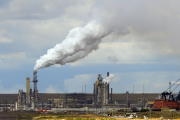By Clare Demerse and Matthew Bramley
Even if you're a casual election observer, you've probably heard something about "carbon pricing" in this campaign. From party brochures to attack ads, the idea of fighting global warming by charging polluters has cropped up on a daily basis. And as last week's leaders' debates showed, no party is immune to using some serious political spin to sell its approach.
Because it's such a crucial way to cut Canada's greenhouse gas pollution, we decided to take a closer look at the major parties' commitments on carbon pricing. We wanted to dig a bit deeper - to cut through the politics and get to the heart of the policy.
The good news is that all five parties acknowledge that climate change is a crisis, and we're finally having a national debate about the solutions. But scientists tell us that the world needs dramatic action within a decade to avoid catastrophic impacts, and Canada is already far behind its peers. So we have absolutely no time to waste in getting this policy right.
Our assessment uncovered some strong elements from several parties, some areas in dire need of improvement, and more than a few unanswered questions. We found that the differences between the parties are stark: some are willing to move much further and much faster than others.
Essentially, carbon pricing aims to ensure that polluters pay the cost of their pollution, and harness the power of the marketplace to clean it up. There are two main ways to do this: a carbon tax or a cap-and-trade system. The latter option sets a cap on pollution and allows polluters to "trade" allowances amongst themselves to reduce their costs.
The term "carbon" comes from carbon dioxide, the most important of the greenhouse gases that cause global warming. Carbon dioxide from burning fossil fuels - including coal in power plants or gasoline in vehicles - makes up 70 percent of Canada's greenhouse gas pollution.
When governments attach a cost to those emissions, they create an economy-wide incentive to pollute less. And even a modest carbon price can raise a lot of revenue that governments can invest in clean technology, or in reducing other taxes.
A carbon price is not a silver bullet: we're also going to need regulations to improve energy efficiency and new investments in public transit, green electricity and buildings. But putting a price on carbon has to be at the centre of any serious plan to move Canada away from polluting activities and toward cleaner alternatives.
It's not just environmentalists who believe this: some of the strongest support for carbon pricing comes from economists. Last year, 70 economists wrote to B.C. Premier Gordon Campbell in support of a carbon tax, stating that it would help achieve "a stronger economy, and a brighter future for our children." And the Conference Board of Canada has said that this country needs to go "much further, much faster" in introducing both a carbon tax and a cap-and-trade system.
That last point may sound surprising, because some politicians have presented carbon pricing as a choice between two very different paths. Some have even embraced one alternative while labelling the other as a risky choice that could hurt our economy.
In fact, the two mechanisms are a lot closer than they appear. Both will affect consumers as well as companies. Both can be effective at cutting emissions, and either can fail if poorly designed. If they're strong enough to be effective, both would create some additional costs, but also many new economic opportunities.
To assess the parties, we used seven criteria to gauge the environmental effectiveness of their commitments, including the carbon price level, the breadth of the plan's coverage, and the use of revenues.
We also identified three key "fairness" criteria: avoiding exemptions, providing compensation to low-income Canadians, and protecting vulnerable industries in a targeted way.
It's probably not surprising to hear that the Green Party performs well on most of these criteria. Its plan calls for the highest price on emissions through a $50/tonne carbon tax that would go into effect immediately. The party would use the revenues raised to cut other taxes, but would also invest public funds in cutting emissions.
The Conservative proposal fared poorly in our assessment, for several reasons. The party proposes to set targets for industry based on "emissions intensity," which means that actual emissions will rise if industrial production grows quickly. In fact, the federal government has acknowledged that its plan will allow emissions from Alberta's tar sands to nearly triple between 2006 and 2017. And the Conservatives plan to allow companies to make use of complicated "compliance options" that create additional uncertainty about the proposal's effectiveness.
The NDP received a mixed score in our assessment. Its cap-and-trade proposal sets a relatively strong price of $35/tonne, but it's not clear how the system could be up and running as quickly as the party says it would be. Jack Layton's plan would re-invest the revenue raised from his carbon pricing plan in programs like building retrofits, public transit and green job creation.
The Liberal Party's approach is best described as a "reasonable first step." Stéphane Dion's carbon tax would reach $40/tonne in its fourth year, and the funds generated from the tax would be used to cut other taxes. Like the Greens, the Liberal proposal would cover a relatively large portion of Canada's economy, opening up more opportunities to reduce emissions.
Of course, it will take much more than the contents of one election's platforms for Canada to do its fair share in fighting global warming. But the reality is that voters will have a choice between very different levels of ambition in that fight when they cast their ballots on Tuesday.
Clare Demerse is a senior policy analyst in the Pembina Institute's climate change program, and Matthew Bramley is the program director. Their assessment of the major parties' carbon pricing policies is available at here.
950 words






